When it comes to Akoya pearl grading, understanding the intricate process is essential for anyone looking to invest in these exquisite gems. Akoya pearls are renowned for their luminous beauty, but their quality can vary significantly. To make an informed purchase, one must grasp the principles of Akoya pearl grading. Let’s delve into this fascinating world of pearl evaluation.
The Significance of Akoya Pearl Grading
Akoya pearls come in various sizes, shapes, and colors, making each one unique. The art of grading Akoya pearls helps consumers identify the quality and worth of these treasured gems. Whether you’re shopping for yourself or a loved one, knowing how Akoya pearls are assessed is a valuable skill.
Factors That Influence Akoya Pearl Value
The value of Akoya pearls is influenced by multiple factors, and understanding these criteria is crucial for making an informed decision.
1. Size Matters
The size of an Akoya pearl plays a significant role in determining its value. Larger pearls are generally more valuable than their smaller counterparts. However, size alone is not the sole determinant of worth; other factors must also be considered.
2. The Quest for Perfection: Pearl Shape
The round shape is the most coveted among pearls, including Akoya pearls. Their spherical perfection is rare and, as a result, commands a higher value than off-round or drop-shaped pearls. The pursuit of perfection leads to a premium in the world of pearls.
3. The Captivating Colors
Akoya pearls are celebrated for their classic white, pink, golden, and black body colors. The dominance of these shades has made them highly sought after in the world of pearl jewelry. Additionally, the presence of rare overtones can further enhance a pearl’s value.
4. The Lustrous Allure
Luster is perhaps the most important factor when evaluating Akoya pearls. It is the luster that imparts a cultured pearl’s beauty. Professionals classify luster on a scale ranging from poor to excellent. A pearl with excellent luster possesses a brilliant, sharp, and distinct reflection, enhancing its overall appeal.
5. Unveiling Surface Quality
Surface quality is another crucial factor in Akoya pearl grading. While some surface characteristics may go unnoticed by the naked eye, others are more prominent and can impact a pearl’s value. Fewer blemishes and imperfections on the pearl’s surface equate to a higher overall value.
6. Nacre: A Delicate Balance
Nacre quality is closely related to luster but is a distinct factor. High-quality pearls feature a thick layer of nacre, which enhances luster and ensures the pearl’s durability. Nacre thickness and quality are essential considerations when assessing Akoya pearls.

The Intricate Process of Akoya Pearl Grading
Evaluating Akoya pearls is a meticulous process that demands skill, expertise, and a discerning eye. No two pearls are identical, and the differences between them often require a professional’s expertise to discern. The process involves examining several factors that contribute to Akoya pearl quality.
1. Sifting Through Thousands
Pearl sorters embark on a daunting task when evaluating Akoya pearls. They must sift through thousands of pearls to categorize and re-categorize them based on their individual qualities. A single strand of perfectly matched pearls may require examining approximately 10,000 Akoya pearls.
2. Sorting by Quality
Sorters meticulously examine each pearl to determine its quality. They use their expertise to categorize the pearls based on various criteria. This process ensures that each pearl falls within the appropriate category based on its unique attributes.
3. Akoya Pearl Quality Categories
Akoya pearl quality is classified into several categories, each denoting specific quality standards. The primary factors that determine these categories are luster, size, shape, color, surface quality, and nacre quality. Let’s explore these categories in greater detail.

Exploring Akoya Pearl Quality Categories
The Akoya pearl grading process involves several quality categories, each indicating different levels of pearl quality. Understanding these categories will empower you to make informed decisions when choosing Akoya pearl jewelry.
AAA-Grade Akoya Pearls
- Luster: Excellent
- Size: Larger, highly valuable pearls
- Shape: Predominantly round
- Color: Vibrant, classic colors with distinct overtones
- Surface Quality: Minimal blemishes or imperfections
- Nacre Quality: Thick nacre layer, ensuring durability and enhanced luster
AA-Grade Akoya Pearls
- Luster: Very good to excellent
- Size: Slightly smaller than AAA-Grade pearls
- Shape: Predominantly round, with some off-round pearls
- Color: Classic colors with noticeable overtones
- Surface Quality: Few visible blemishes or imperfections
- Nacre Quality: Adequate nacre thickness, resulting in good luster
A-Grade Akoya Pearls
- Luster: Good to very good
- Size: Smaller than AA-Grade pearls
- Shape: Varied shapes, including off-round and drop pearls
- Color: Traditional colors with subtle overtones
- Surface Quality: Some noticeable surface blemishes
- Nacre Quality: Adequate nacre thickness, contributing to satisfactory luster
B-Grade Akoya Pearls
- Luster: Good
- Size: Smaller than A-Grade pearls
- Shape: Mixed shapes, with irregular and off-round pearls
- Color: Traditional colors with less pronounced overtones
- Surface Quality: Visible surface blemishes
- Nacre Quality: Minimal nacre thickness, resulting in moderate luster

Factors That Influence Akoya Pearl Grading
Several factors influence the grading of Akoya pearls, each contributing to their overall quality. These factors include:
- Luster: The brilliance and shine of a pearl, ranging from poor to excellent.
- Size: The diameter of the pearl, with larger pearls generally commanding higher values.
- Shape: The roundness of a pearl, with perfectly round pearls being the most valuable.
- Color: The body color and presence of overtones, with classic white, pink, golden, and black shades being highly regarded.
- Surface Quality: The presence of surface blemishes, with fewer imperfections increasing a pearl’s value.
- Nacre Quality: The thickness and quality of the nacre layer, affecting durability and luster.
The Impact of Akoya Pearl Grading on Value
The meticulous process of Akoya pearl grading significantly influences the value of these cherished gems. Understanding how each factor contributes to a pearl’s quality allows consumers to make informed decisions and select pearls that align with their preferences and budget. Whether you seek the pristine radiance of AAA-Grade pearls or the affordability of B-Grade pearls, Akoya pearl grading provides a structured framework for assessing these treasures from the sea.
The Timeless Allure of Akoya Pearls
Akoya pearls continue to captivate jewelry enthusiasts with their timeless elegance. Whether you’re looking for a classic strand of pearls or a unique pearl-accented piece, the world of Akoya pearls offers a wealth of options. With the knowledge of Akoya pearl grading, you can confidently explore the world of pearl jewelry and discover the perfect piece to adorn yourself or a loved one. The beauty and value of Akoya pearls make them a truly timeless treasure.
Find out more about pearl qualities from our video below:
Explore our exquisite collection of Akoya pearl jewelry and add a touch of timeless allure to your jewelry collection.
FAQs
When shopping for Akoya pearl jewelry, it’s essential to consider the grading criteria, which include factors like luster, size, shape, color, surface quality, and nacre quality. A reputable jeweler will provide information about the pearls’ grade, allowing you to make an informed choice.
Yes, Akoya pearls are renowned for their exceptional luster. Luster is a crucial factor in evaluating pearl quality, and Akoya pearls are often classified as the most lustrous of all pearl types. Their radiant, sharp reflections set them apart in the world of pearls.
To keep your Akoya pearl jewelry looking its best, avoid exposure to harsh chemicals, perfumes, and excessive moisture. Gently wipe the pearls with a soft, damp cloth after wearing them to remove any residue. Store your pearls separately from other jewelry items to prevent scratches. Periodically restring your pearl strands to ensure their security and longevity.

